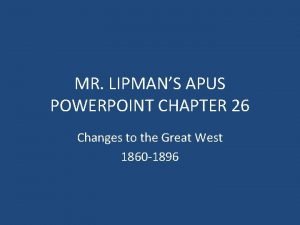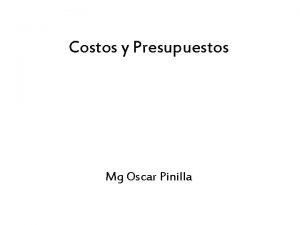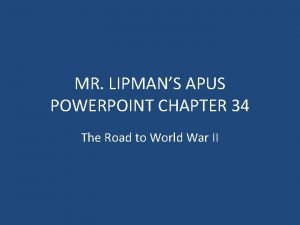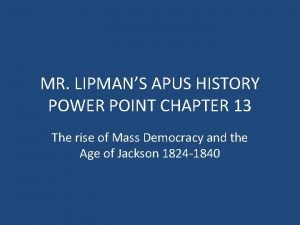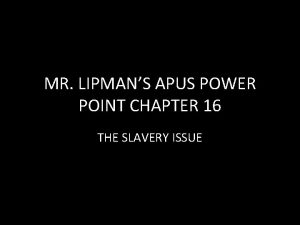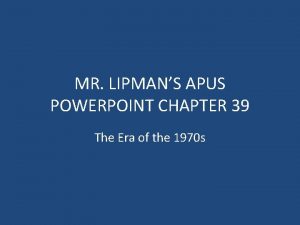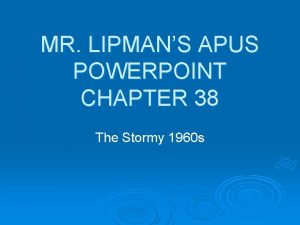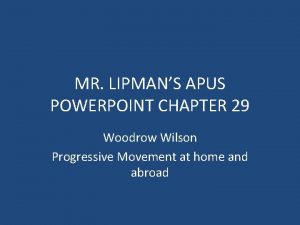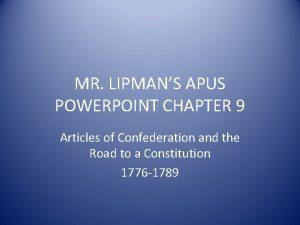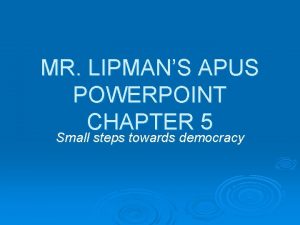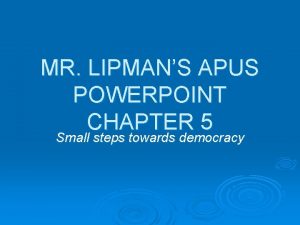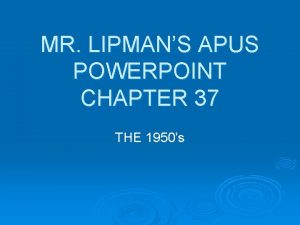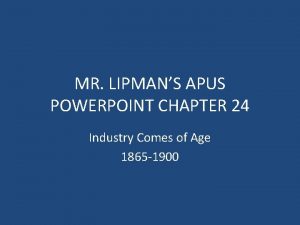MR LIPMANS APUS POWERPONT CHAPTER 25 The Move






































- Slides: 38

MR. LIPMAN’S APUS POWERPONT CHAPTER 25 The Move to Urbanization 1865 -1900

Keys to the Chapter • • Urbanization Immigration Nativism Education Booker T. Washington vs. W. E. B. Du. Bois Publisher Wars Reform Movements caused by a changing society

The Shift to the City The % of population living in cities doubles from 1860 to 1900

Urban Growth, 1870 – 1900 NYC and Chicago take the lead

• Many people from rural America drawn into cities – Not only for jobs, but for the more glamorous and technological city lifestyle – Huge department stores (Macy’s, Marshall Field’s) attracted middle-class shoppers and gave lowerclass jobs (mainly to women) – Skyscrapers made possible by the electric elevator – Trains allow for cities to expand their “radius” – Waste removal becomes an issue – Urban slums develop and criminal activity grows – Tenement living becomes a big issue (Jacob Riis)

The Urban Slum

Overcrowding in New York City

The New Immigration • Immigrants from Europe poured into US – 1850 s – 1870 s – about 2 million per decade – By 1880 s – about 5 million per decade entered US Prior to 1880 s most immigrants came from England or Western Europe but starting in 1880 s it becomes primarily Eastern Europe (Jews) and Southern Europe (Italian) and religious conflicts arise

Old and New Immigration – Note Increase of Southern/ Eastern Europe

• Pushes (reasons being pushed out of Europe) – Rapid population growth in Europe because of food imports from US and cultivation of potato brings overcrowding and joblessness in cities – Poverty of displaced farm workers driven from the land by mechanization and food imports from US – Religious persecution, especially in Russia against the Jews • Pulls (reasons bringing people to America) – “America letters” sent by immigrants telling of opportunity – US reputation for political and religious freedom – Economic opportunities advertised by American business interests who want cheap, unskilled labor – Large steamships and relatively inexpensive one-way passage

• Job of taking care of immigrants went to bosses and political machines because government did little – In return for immigrants’ votes, boss provided jobs on city payroll, housing for newly arrived, gave food and clothes to poor, helped fix small problems with law, and got parks and schools built in immigrant neighborhoods – In spite of corruption, bosses gave immigrants needed assistance that no one else did Social reformers would gradually work to help fix urban problems, including those of immigrants, by making them issues that people cared about

The City Boss

• “social gospel” movement – Protestant ministers who tried to apply the lessons of Christianity to the urban slums – Called on churches to use the lessons of the Sermon on the Mount to fix problems in society – Made middle class aware of problems of poor, leading to progressive reforms in early 1900 s • The settlement house movement { Jane Addams Chicago starts Hull House 1890 s} – Located in poor, ethnic neighborhoods in big cities – Provided instruction in English – Provided child care for working mothers – Hosted cultural activities

• Other followed Addams’ lead, forming settlement houses in big cities • Settlement houses became centers of women’s activism for social reform (protection laws for women and child workers are sought) • Some women entered into careers in social work after working in settlement houses • Job Opportunities for women in the cities – Mostly single women because of taboo against married women working – Women’s jobs depended on race, ethnicity, class – Long hours, low pay, limited advancement

• 1880 s – strong anti-foreignism against New Immigrants aroused (Nativism) – Feared foreigners (with a higher birthrate than native-born Americans) would outbreed them – Feared mixture of foreigners with Anglos, “mongrelizing” American race – Blamed immigrants for corruption of city governments – Workers in unions attacked immigrants’ willingness to work for “starvation” wages – Immigrants blamed for radical ideas (socialism, communism, anarchism)

Uncle Sam Refuses Entrance to a Foreign “Radical”

• Unions supported anti-immigrant causes – Immigrants used as strikebreakers – Immigrants pushed wages down – Immigrants difficult to unionize because of language barrier – If American business got protection (through tariffs), American workers should get protection (through immigration restrictions) – 1882 Chinese Exclusion Act bans Chinese immigrants – 1886 Statue of Liberty opened (saying opp. of belief) – 1917 Literacy Tests finally adopted into law for immigrants

Looking Backward- How they forgot

• Darwinism challenged core of established religions – Idea that higher forms of life had evolved through “natural selection” – Explicit rejection of “special creations”, design of each fixed species by divine (supernatural) agency – By 1875, most scientists came to believe in evolution, although there was disagreement over Darwinism – By the 1920 s – most scientists had come to accept Darwinism

• Religion’s reaction to Darwinism – first, many scientists and religionists oppose but – After 1875 churches split into 2 groups • Conservative minority firmly behind literal interpretation of Bible (leading to fundamentalism) • “Accommodationists” reconciled Darwinism with Christianity; did not accept Bible (in its entirety) as history or science {wanted to keep people in church} • Impact of Darwinism – Religious foundations of Americans shaken but accommodationists kept many in churches – Religious teaching kept to personal faith and private conduct – Science explained external world instead of religion

The Lust for Learning - Education • Elementary schools – After Civil War, more states made grade school education compulsory – Helped also stop some of the worst abuses of child labor, kids in school instead of factories High schools – Before 1880 s – public high schools rare – 1880 s – 1900 s – free public high schools established, along with free books

A School in New York, 1886

• The problem of education in the South – South far behind and blacks even further behind • Booker T. Washington – 1881 – took lead at industrial school in Tuskegee, Ala. – Taught blacks useful trades so that they could gain economic security and self-respect – “accommodationist” because he did not challenge white supremacy or racism; accepted inequality – Believed social equality (with political and civil rights) would come after achieving economic security – George W. Carver important teacher at Tuskegee

• W. E. B. Du. Bois – Northern black who earned Ph. D. from Harvard (first black to do so) – Helped found NAACP – Demanded complete equality for blacks (social and economic), rejecting Washington’s gradualism – Called for “talented tenth” of blacks to lead and be given full and equal access to mainstream WASHINGTON VS. Du. BOIS WOULD BE THE FIGHT FOR THE BLACK COMMUNITY

• Morrill Act of 1862 (got Feds involved in education) – Gave large grants of public land to states for public education {The A&Ms} • Hatch Act of 1887 – Extended Morrill Act to provide federal funds for agricultural experiment stations at land-grant colleges • Morrill and Hatch Acts helped create over 100 colleges and universities in US • Private philanthropy (charity) helped build many colleges – Many new industrial millionaires gave money to build colleges {Cornell, Stanford, University of Chicago }

The Appeal of the Press • Changes in journalism – Linotype (invented 1885) • Machine replaced labor-intensive typesetting by hand • Led to more newspapers being printed, but at higher costs (to buy the Linotype machines) • Newspapers have to rely on advertising, making them write tamer articles to not offend advertisers – Appeal to immigrants and masses (less educated) • Stories about sex, scandal to catch and keep their attention

• 2 news tycoons compete to provide sensationalistic news to gain more subscribers to their chains of papers {yellow journalism) – Joseph Pulitzer • New York World – William Randolph Hearst • San Francisco Examiner Magazines become much more popular as education increases the number of literate readers

Popular Reform Authors • Henry George, Progress and Poverty (1879) – Inequality because there was a fixed amount of land, but an increasing population wanted to limit profits from land sales • Edward Bellamy, Looking Backward (1888) – man falls asleep in 1887, wakes up in 2000 – Finds that social & economic injustices ended by government nationalizing big business to operate in public’s interest – Influenced future reform movements

• Horatio Alger – Sold millions of books with stock formula of the hero triumphantly overcoming obstacles with honesty, virtue, work Walt Whitman (poetry) Emily Dickenson (poetry) • Mark Twain – Wrote in rough vernacular – The Gilded Age (1873) • Satire of postwar politicians and speculators – Tom Sawyer (1876); Huckleberry Finn (1884) • Two very important books about realities of life and racism in the South

• Stephen Crane (died of T. B. at 29) – Maggie: A Girl of the Streets (1893) about a poor prostitute driven to suicide – The Red Badge of Courage (1895) about a young, wounded Civil War recruit • Theodore Dreiser – Sister Carrie (1900), a graphically realistic novel about a poor working girl in Chicago; the girl rejected traditional moral standards – JACOB RIIS – HOW THE OTHER HALF LIVES

The New Morality • Late 1800 s – culture battle over sexual freedom and role of women in society – “new morality” – greater freedom in sexuality (brought about in part by women’s greater economic freedom) – Signs of the new morality: divorce, birth control, open discussion of sexual topics – Battle exemplified by clashes between Victoria Woodhull and Anthony Comstock

• Victoria Woodhull – Proclaimed belief in free love; worked for feminism and Published radical magazine • Anthony Comstock – Campaigned against “immorality” – Used 1873 Comstock Law to confiscate and destroy sexuality explicit pictures, books, and magazines, including info about birth control – Divorce rate increased – Birth rate decreased

Give Mother the Vote – We Need It Push starts in 1900 to increase power of women politically

• Women’s gains toward suffrage – States began allowing women to vote in local and sometimes state elections (strongest in West) – 1869 – Wyoming granted first to be unrestricted • Other states followed – Women also gained right to own property and formed women’s organizations at the same time – White women restricted black women’s membership in their suffrage and social groups – Ida B. Wells • Began nationwide anti-lynching campaign • Helped black women form their own organizations for suffrage and equality

Woman Suffrage Before the Nineteenth Amendment

Woman’s Holy War -------The fight against alcohol --------Temperance Movement

Statewide Prohibition Before 1919

• 1893 – Anti-Saloon League formed – Made important gains in states, banning alcohol • 1919 – 18 th Amendment banned alcohol nationally but Repealed in 1933 • Other reform societies – 1866 – ASPCA – 1881 – American Red Cross • Led by Clara Barton, nurse from Civil War SPORTS AND THEATOR BECOME MORE WIDESPREAD AS LESIURE TIME INCREASES ALONG WITH INCOME
 Lipmans party store
Lipmans party store Calcular bloques por m2
Calcular bloques por m2 Jaguar ure
Jaguar ure Que significa pisco en quechua
Que significa pisco en quechua What has roads but no cars rivers but no water
What has roads but no cars rivers but no water Hát kết hợp bộ gõ cơ thể
Hát kết hợp bộ gõ cơ thể Ng-html
Ng-html Bổ thể
Bổ thể Tỉ lệ cơ thể trẻ em
Tỉ lệ cơ thể trẻ em Voi kéo gỗ như thế nào
Voi kéo gỗ như thế nào Chụp tư thế worms-breton
Chụp tư thế worms-breton Hát lên người ơi alleluia
Hát lên người ơi alleluia Kể tên các môn thể thao
Kể tên các môn thể thao Thế nào là hệ số cao nhất
Thế nào là hệ số cao nhất Các châu lục và đại dương trên thế giới
Các châu lục và đại dương trên thế giới Công thức tiính động năng
Công thức tiính động năng Trời xanh đây là của chúng ta thể thơ
Trời xanh đây là của chúng ta thể thơ Mật thư anh em như thể tay chân
Mật thư anh em như thể tay chân Phép trừ bù
Phép trừ bù độ dài liên kết
độ dài liên kết Các châu lục và đại dương trên thế giới
Các châu lục và đại dương trên thế giới Thơ thất ngôn tứ tuyệt đường luật
Thơ thất ngôn tứ tuyệt đường luật Quá trình desamine hóa có thể tạo ra
Quá trình desamine hóa có thể tạo ra Một số thể thơ truyền thống
Một số thể thơ truyền thống Cái miệng bé xinh thế chỉ nói điều hay thôi
Cái miệng bé xinh thế chỉ nói điều hay thôi Vẽ hình chiếu vuông góc của vật thể sau
Vẽ hình chiếu vuông góc của vật thể sau Biện pháp chống mỏi cơ
Biện pháp chống mỏi cơ đặc điểm cơ thể của người tối cổ
đặc điểm cơ thể của người tối cổ V cc
V cc Vẽ hình chiếu đứng bằng cạnh của vật thể
Vẽ hình chiếu đứng bằng cạnh của vật thể Tia chieu sa te
Tia chieu sa te Thẻ vin
Thẻ vin đại từ thay thế
đại từ thay thế điện thế nghỉ
điện thế nghỉ Tư thế ngồi viết
Tư thế ngồi viết Diễn thế sinh thái là
Diễn thế sinh thái là Dot
Dot Các số nguyên tố
Các số nguyên tố Tư thế ngồi viết
Tư thế ngồi viết
